Sourdough Cinnamon Buns
These Sourdough Cinnamon Buns are the best cinnamon rolls ever! There’s a bonus “sticky bun” layer at the bottom & cream cheese frosting on top. WOW!
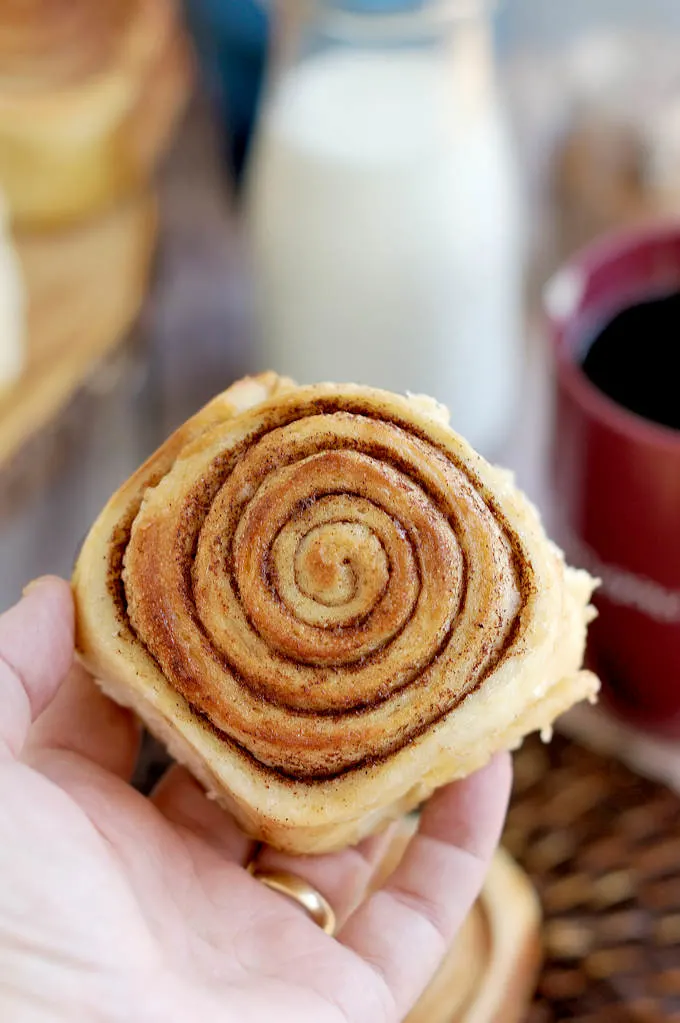
Does anything in the world smell as good as freshly baked Cinnamon Buns? I know, stupid question.
I think we can all agree that even a bad cinnamon bun (aka cinnamon roll) is pretty good. But we can do better. Two things set this recipe apart from other Cinnamon Bun recipes.
First and foremost, the dough is made with sourdough starter instead of commercial yeast. If you love to bake bread but haven’t delved into the world of sourdough yet, I encourage you to dive-in head first.
If you don’t already have one, I can show you how to make a sourdough starter and how to feed a sourdough starter.
You cannot imagine how a little sourdough starter enhances the taste and texture of any bread recipe. That’s a long-winded way of saying that these Sourdough Cinnamon Buns are extra yummy because of the starter.
Click through the slideshow to see how to assemble Sourdough Cinnamon Buns:
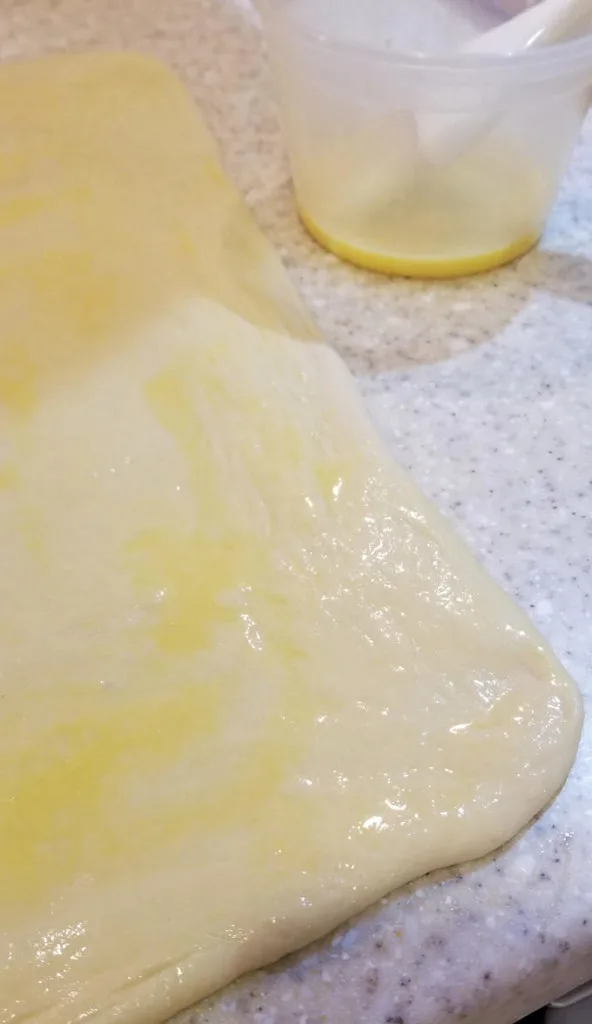
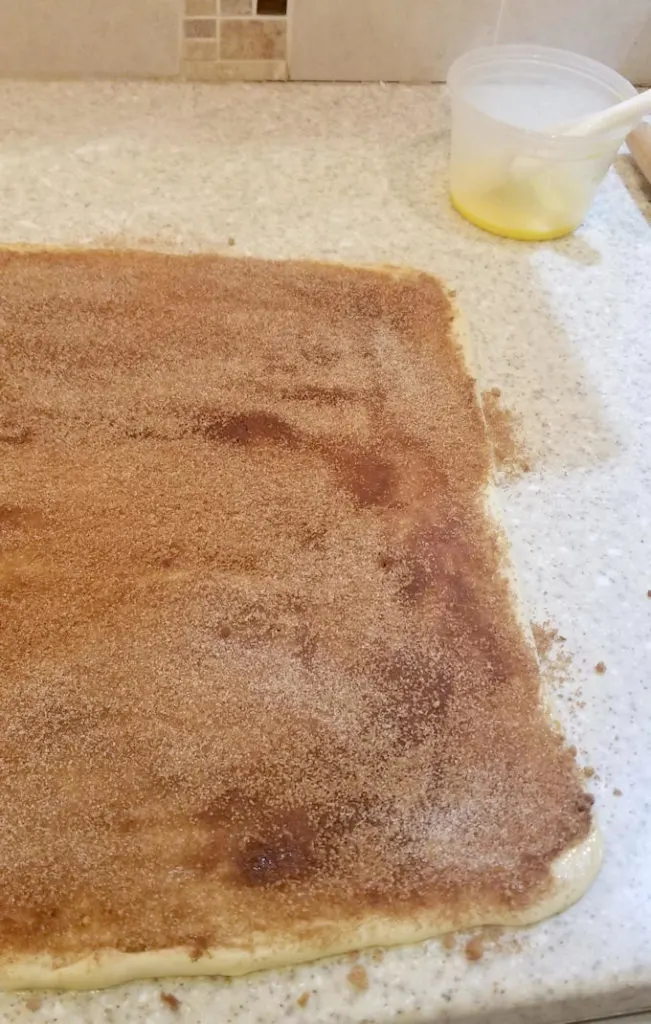
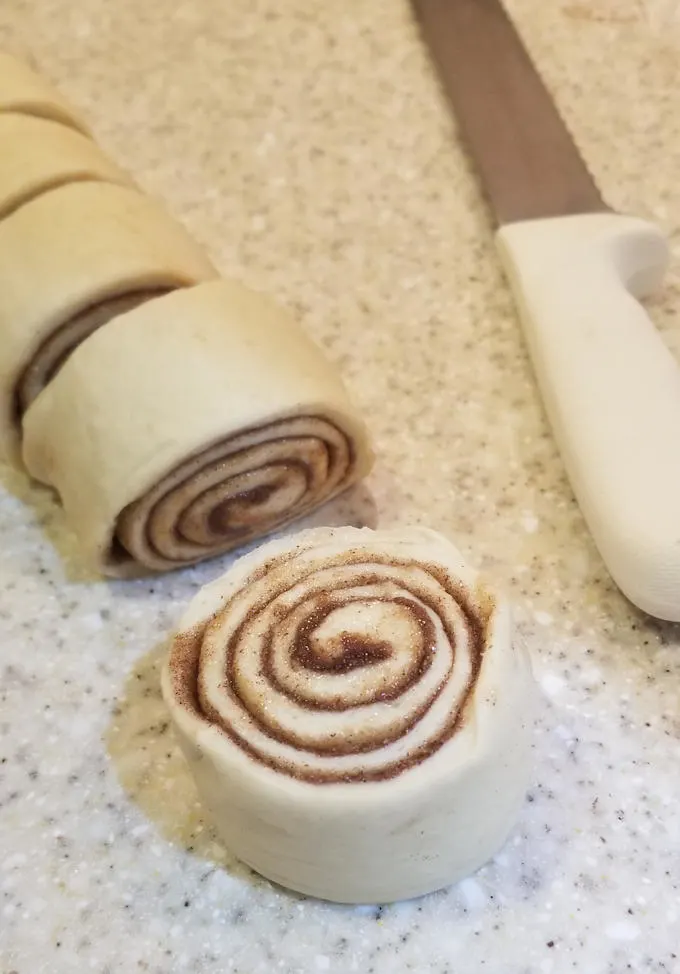

The other thing that sets this recipe apart is the result of a happy-mistake. Because I wanted lots of cinnamon sugar in the buns, I sprinkled a whole cup of sugar over the dough before rolling it up to form the buns.
This is an “overnight” recipe, so the assembled buns spend a night in the refrigerator. That’s great because you can do most of the work the day before and then bake the buns in the morning.
The first time I tested the recipe I found that during the overnight rest in the refrigerator some of the sugar “melted” and formed a syrup at the bottom of the pan.
But, hey, you know what? That syrup bakes up to form a sticky, gooey bottom layer on the buns, which is really quite nice. So I embraced the “mistake” and it’s now part of the recipe.
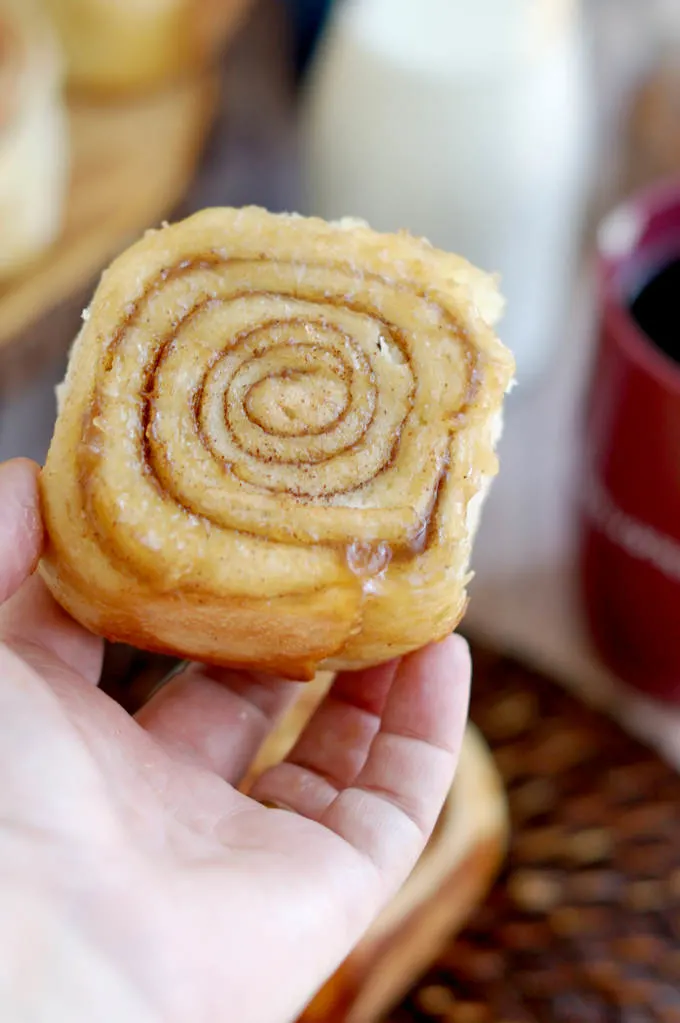
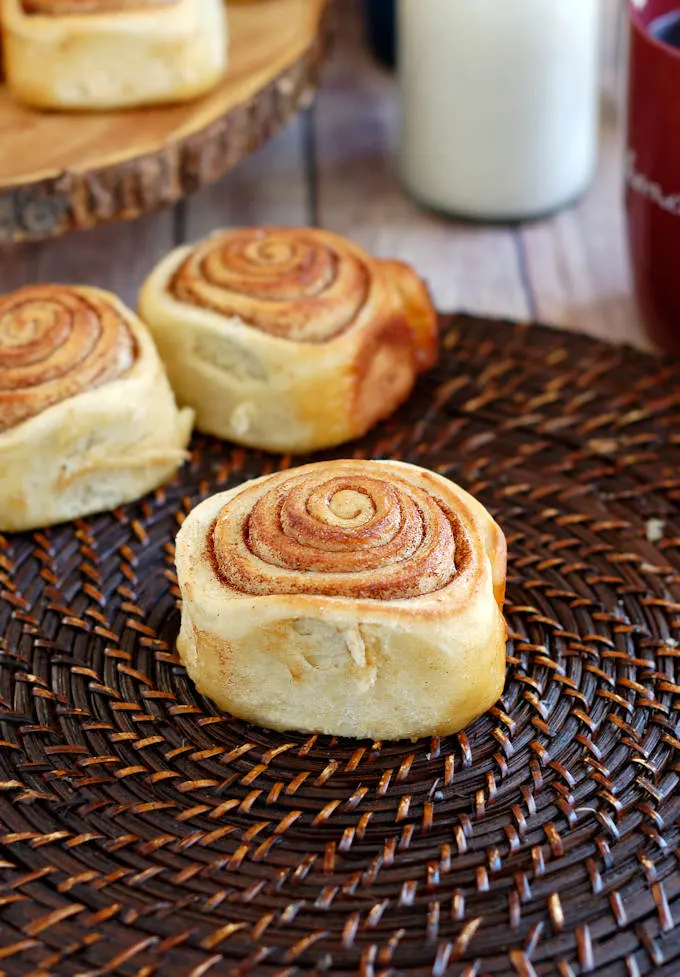
Tips for making great Sourdough Cinnamon Buns (sourdough cinnamon rolls)
- To work ahead the logs can be wrapped tightly in two layers of plastic wrap. Freeze for up to 3 months. Defrost the dough overnight in the refrigerator, then proceed with the recipe as listed.
- To bake the buns the same day instead of putting the pan in the refrigerator, let the the buns rise at room temperature until they almost fill the pan. Bake as directed.
- To get the chilled buns active I like to warm them up a bit. Turn on the oven for just a minute or two to get it just a little warm. Turn off the oven then place the pan with the buns in the barely warm oven. Once they’re starting to rise remove the pan from the oven. You can then preheat the oven while the buns finish rising.
So it’s kind of a twofer recipe; sticky bun on the bottom and iced cinnamon bun on top. Who’s going to complain about that? Not me!
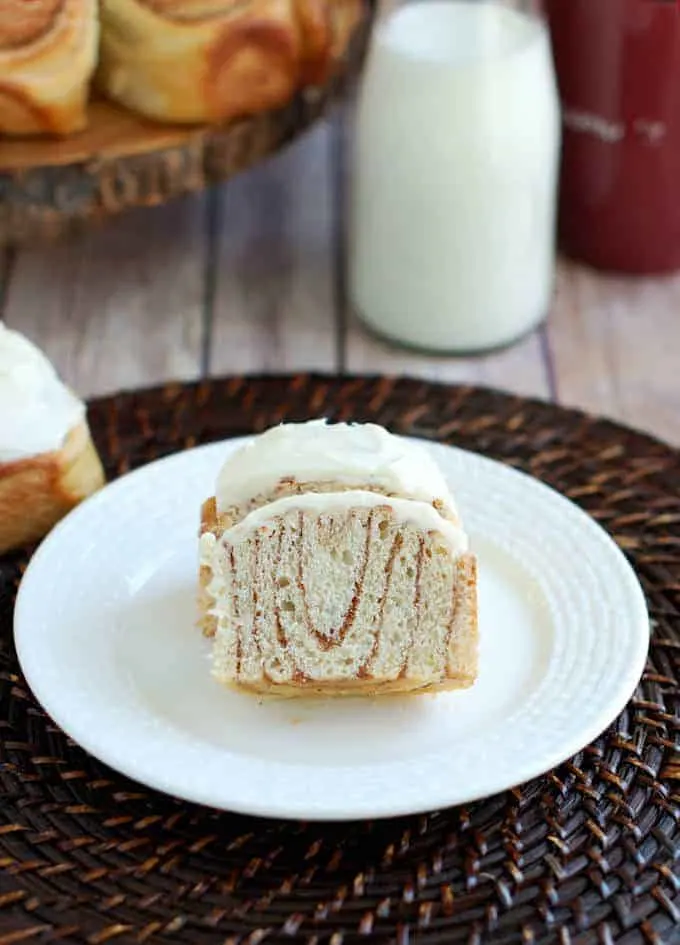
I know you hate to throw away that sourdough discard. Check out these recipes that use sourdough discard.
If you love this recipe as much as I do, please consider giving it a 5-star review.
Overnight Sourdough Cinnamon Buns
Ingredients
For the Dough
- 8 oz active sourdough starter (1 cup, 100% hydration)
- 2 oz warm water (¼ cup)
- 8 oz whole milk (1 cup, scalded and cooled)
- 20 oz unbleached all purpose flour (4 cups, see note)
- 3 oz sugar (⅓ cup)
- 2 oz unsalted butter (¼ cup, melted)
- 1 large egg
- 1 teaspoon table salt
For Assembly:
- 2 oz unsalted butter (¼ cup, melted)
- 4 oz granulated sugar (½ cup)
- 4 oz brown sugar (½ cup)
- 1 tablespoon ground cinnamon
- 1 egg for egg wash
For the Icing
- 2 oz unsalted butter (room temperature)
- 3 oz confectioner’s sugar (¾ cup)
- 2 oz cream cheese (room temperature)
- 1/2 teaspoon vanilla extract
- 1/2 teaspoon lemon juice (optional)
Instructions
- In a mixer bowl combine 8 oz active sourdough starter, 2 oz warm water, 8 oz whole milk and 2 cups (10 oz) of the flour. Mix to form a thick batter. Cover the bowl and set aside to rise for 30 minutes.
- Add 3 oz sugar, melted 2 oz unsalted butter, 1 large egg and 1 teaspoon table salt then mix to combine. Change to the dough hook if using a stand mixer. With mixer on low add the remaining flour, 1/2 cup at a time. The dough should be soft and elastic, will clear the sides of the bowl and gather on the hook. Knead for 5 minutes. If mixing by hand continue mixing and then kneading in the flour by hand. Dump the dough onto a lightly floured surface. Knead into a smooth ball.
- Transfer the dough to a lightly oiled bowl, turning once to coat the dough. Cover the bowl and set it aside at room temperature. After 30 minutes uncover the bowl, lift one side of the dough over into the middle of the dough. Repeat with the other three sides of the dough then flip the dough over. Cover the bowl and every 60 minutes repeat the procedure for a total of 3 hours fermentation time. By now the dough should be lively, elastic and airy. If the dough is still sluggish give it another hour or two at room temperature.
- Generously brush a 9” x 13” baking pan with some of the melted butter, reserve the rest. In a small bowl, combine 4 oz granulated sugar, 4 oz brown sugar and 1 tablespoon ground cinnamon. Turn the dough onto a floured surface without kneading out the air. Roll the dough to a 18" x 16" (46cmx41cm) rectangle. Generously brush the surface of the dough with egg wash. You should use almost 1/2 the egg wash to get a good coating so the cinnamon sugar will stick. Sprinkle the cinnamon sugar over the egg washed dough. Use your hands to smooth out the cinnamon sugar to an even layer all the way to the edge of the dough.
- Working from the long side, tightly roll the dough into a log, pinch the seam to seal. Straighten out the log so it's of even thickness and is 18" 46cm) long (see note).
- Use a serrated knife to cut the log into twelve 1.5" (3.5cm) wide buns. Place the buns in the prepared pan. Generously brush the tops of the buns with the melted butter. Cover the buns with plastic wrap and refrigerate overnight (see note).
- In the morning take the pan out of the refrigerator. You’ll see some melted sugar in the bottom of the pan, this will form a sticky bottom as the buns bake. Allow the buns to proof at room temperature until they’re puffy and almost filling the pan, about 1.5 – 2 hours. The exact time needed for proofing will vary depending how active your starter was and the temperature of your kitchen.
- Preheat the oven to 375°F (190°c) Bake the buns until they’re until golden brown and set in the center, 25-30 minutes.
- While the buns are baking, make the icing. Combine 2 oz unsalted butter and 3 oz confectioner’s sugar in a mixing bowl and cream until well combined. Add the 2 oz cream cheese and whip until well aerated. Add 1/2 teaspoon vanilla extract and optional 1/2 teaspoon lemon juice. The lemon juice will spark the flavor of the icing but it's ok to go without.
- Remove the buns from the pan to a serving plate while they are still warm. Spread cream cheese icing generously over the buns and indulge.
Would you like to save this recipe?
As an Amazon Associate and member of other affiliate programs, I earn from qualifying purchases.



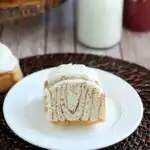





Hi Eileen. Love your recipes & this one in particular is a favorite. I’m making 2 batches for family for July 4th & was wondering if the unbaked rolls can be refrigerated in the pan for 48 hours instead of just overnight? I wanted to prep Friday & bake Sunday morning so we have them fresh. They are so good!! Appreciate your hard work on the recipes, especially for us sourdough lovers!
Hi Jenna, it’s so hard to say with sourdough since there are so many variables. If your starter and dough are very active 48 hours might be too long. The buns could over-rise. I have successfully frozen the log of dough. I let the log mostly defrost and then sliced the buns and left them to rise overnight.
@Eileen Gray, thank you for the feedback, great timing.. I was worried about it being too long since my starter is really active. I’ll freeze the logs. Appreciate the timely response
Great. Enjoy!
just made these, but halved the recipe, except for the egg, so a little extra flour, about 20 grams. These are amazing, can’t wait to make them again!
Hi there-
I’m working on this recipe for the first time and scrolled through the comments but didn’t see anything specific to this question. If I roll out the dough and form the log on day 1 and then freeze the log. When I pick up the recipe again, would you still recommend letting the cut rolls it overnight again? Or would I be able to defrost overnight, and then cut and bake the next morning?
Basically I’m making the dough/log today because I have to work tomorrow, but want to bake them on Friday morning. So I’m not sure the best steps to take.
Thanks!
I think it would be fastest to take the frozen log out of the freezer and leave it at room temp until it’s mostly defrosted. Slice the rolls, put them into the pan and leave the pan at room temperature until the rolls are completely defrosted and maybe even starting to rise a bit. Refrigerate before going to bed then finish rising and baking in the morning. I think if you give the dough time to “wake up” the night before the buns will rise faster in the morning. A lot of this will depend on your environment. My kitchen is still quite cool this time of year so this is how I’d do it. In the summer, I’d probably slice, put them into the pan and refrigerate right away since the dough will be more active in a warmer kitchen.
@Eileen Gray, I continued scrolling and did see in one of the comments you mentioned putting the dough in the refrigerator and forming the log and subsequent buns the next morning (Thursday). Then refrigerate them until the next morning (friday) then bake after rising. Since I am working from home tomorrow I should be able to follow this process!
I’m new to sourdough and I can’t come to terms with having to throw out the extra so am looking for lots of recipes. I’ve made this recipe 6 times and have frozen 3 of them for future use. I don’t add the icing as I like them plain but this is fabulous especially when they start to cook and all that good cinnamon smell starts to fill the kitchen. My family of 6 loves them.
I have a question about the starter. I have been keeping mine in the refrigerator but now I’ve been baking so much that I’d like to keep it out. If the starter becomes active by mid to late afternoon, and I leave it out overnight can I use it immediately.? Or do I need to feed it again in the morning and wait. I’d like to begin recipes right away in the morning not wait till afternoon.
I realize it is good to bake some of the things in the afternoon if they have to stay in the refrigerator overnight.
I love making the artisan and sandwich bread. I have also made the hamburger buns, the cinnamon rolls, and the bagels. Next thing I’m going to try is the English muffins
There are no hard and fast rules about the timing with the starter. I find the optimal time to use my starter is just after it’s reached it’s peak and started to recede. If it peaked the day before and you wait overnight to use it, it will work but it won’t be as active. Your dough might be a bit sluggish getting started. I would say if you want to start your dough first thing in the morning, wait until just before bed to feed the starter. It should be nice and active by the morning.